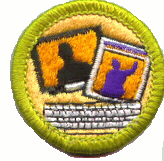Become A Sponsor
|
Why Ads
 |
 |
| Old version |
Current version |
JOURNALISM
These were the REQUIREMENTS before the REVISIONS
made when a new pamphlet was issued during 2006
To see the current requirements
Click Here
PREVIOUSLY, THE REQUIREMENTS WERE COMPLETELY REVISED
effective 04/01/99
Click here for the previous
requirements
- Do ONE of the following:
- Read a local newspaper, a national newspaper, a newsmagazine,
and a computerized online news source. From each of these,
clip stories about the same event. Put each item on a separate
piece of paper. Write an analysis comparing the different
stories explaining how the stories are objective or subjective
and how each publication handled the story differently depending
on its purpose or audience.
- All on the same day, watch a local television newscast,
watch a national network newscast, listen to a radio newscast,
and study the computerized online news provided by a national
news broadcast source. List the different news items, features,
and editorials on the broadcasts, including the time in
minutes and seconds devoted to each story, and print out
a copy of the online edition's "front page." Write an analysis
comparing the different story lists, explaining how the
stories are objective or subjective and why different news
outlets treated the stories differently.
- Do either a OR b:
- Print journalism:
- Visit a newspaper office and tour the various divisions,
including the newsroom, the editorial offices, the business
side, and the printing plant. During your tour, talk
to an editor or reporter about what it's like to be
a newspaper journalist, where they get story ideas,
and what makes a good newspaper. If possible, go with
a reporter and your buddy to cover a news event. Get
your parent's permission first.
- With the help of your counselor, prepare a front-page
newspaper layout. Edit copy, proofread a story after
it has been typeset , and be able to explain the printing
process.
- Broadcast journalism:
- Visit a radio or television station and tour the
various divisions, including the newsroom, the studios,
the control rooms, and the business side. During your
tour, talk to a producer or reporter about what it's
like to be a broadcast journalist, where they get story
ideas, and what makes a good station. If possible, go
with a reporter and your buddy to cover a news event.
Get your parent's permission first.
- With the help of your counselor prepare a television
or radio news show format. Edit audiotape or videotape,
and be able to explain what it takes to broadcast radio
or television news.
- Attend a news event and do ONE of the following:
- Write a newspaper story about the event, a sidebar feature,
and either an editorial or a critical review of the event.
- Using radio or TV style write a newsstory about the
event, a color story and either an editorial or critical
review of the event.
- Take a series of photographs that would help to tell
the story in pictures, including some news photos and some
feature photos. Write cutlines for your photos and a brief
story of the event.
- Answer at least three of five questions about qualifications,
educational preparations, training opportunities, wages, and
personal satisfaction in journalism.
BSA Advancement ID#: 66
Pamphlet Revision Date: 1999
Requirements last updated in 1999
|
Page updated on:
May 08, 2022
|





